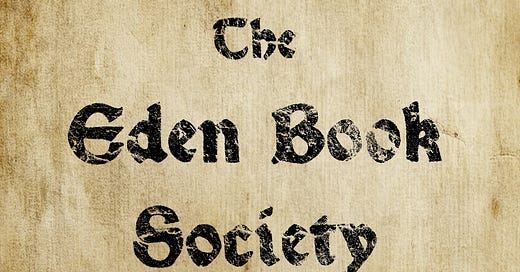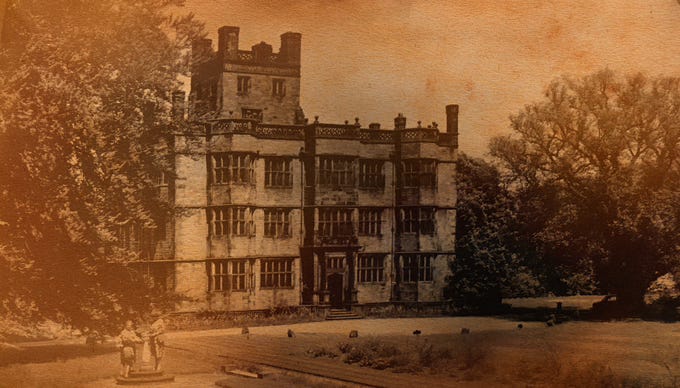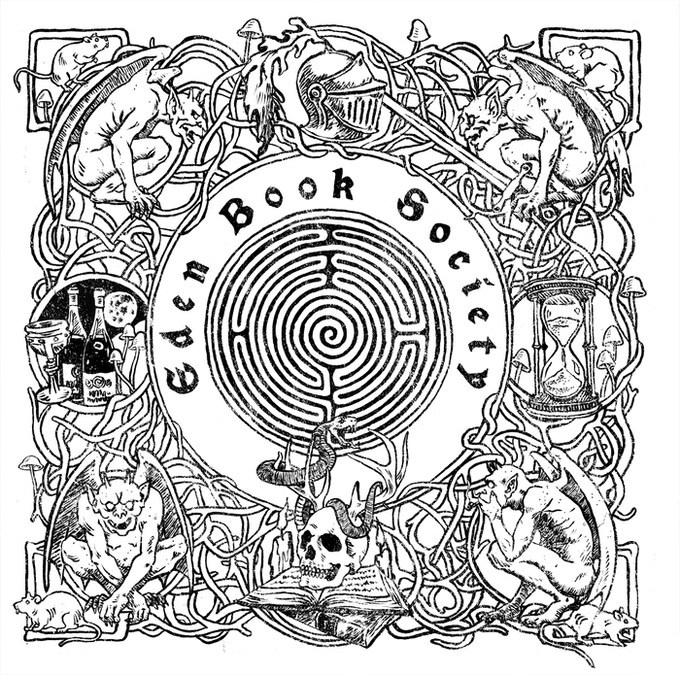My friends, I know my newsletter has been quiet lately. I took a little break to focus on my health both mentally and physically (I had a 6 week post-op recovery that has now ended and I’m feeling good!) I will return to monthly updates in June. If you’re in the Seattle area, come hangout with me & Caitlin Starling at the Seattle Public Library tonight! Our books are being sold by Charlie’s Queer Books
100 Years of Unseen Horror…
The Eden Book Society on Kickstarter
Memories of Marion Scott- ESSAY
By Nina Allan
Marion Scott was born in Croydon on New Year’s Day 1935. Her father, Douglas Scott, had grown up in Glasgow and after working there for some years as a shipping clerk he moved south, founding his own business importing coffee and other products. Marion’s mother Evelyn was the sister of a London business colleague. The two married in 1930 and with the help of Evelyn’s father bought the leasehold on a large apartment on Blackhorse Lane. Marion’s older brother Kenneth was born the following year, with a younger brother Desmond born in 1936.
When Marion was three, Douglas Scott was offered a half-share in a coffee plantation in Kenya, and moved with his family to Nairobi.
‘I could never have dreamed such a place existed,’ Marion wrote of Kenya, later. ‘The vastness of that landscape, the particular light. Even though I was still a young child, my view of the world – of what was possible – became utterly changed.’ The outbreak of war in 1939 changed everything again. The family initially remained in Kenya but by 1942 they had returned to London, where Douglas took on work provisioning the army. It was decided that Marion and Kenneth would be sent north to Scotland, Kenneth to a boarding school in the Highlands, and Marion to live with her paternal grandparents in Banchory, on the river Dee. Though Marion found the colder climate an unpleasant shock after her years in East Africa, she did at least discover echoes of her earlier freedoms in the wild landscape of rural Aberdeenshire, and it was here, in the home of her grandparents, that she came to know the writers who would first inspire her to become a writer herself.
‘The winters in Banchory could seem endless,’ she wrote. ‘Darker evenings, weeks of snow and rain. Fortunately for me, my grandparents had a lot of books. Many were of no interest to a young child – dusty old volumes about Scottish clans and the church and so on – but I loved sorting through those books, because many of them had beautiful leather bindings and strange illustrations. And there was always the hope of stumbling upon something more interesting. There was one I loved about Scottish castles. Another about Scott and Amundsen’s race to the South Pole. But the book that changed my life was a thick compendium of ghost stories called The Mammoth Book of Thrillers, Ghosts and Mysteries. I remember there was a large black bat embossed on the front cover. The moment I saw that bat, I knew the book was for me. And I was right.’ The anthology, published in 1936 by Odhams Press and edited by JM Parrish and John R. Crossland, contains works by some popular pre-war writers including Agatha Christie and GK Chesterton, as well as older writers such as EF Benson, Edgar Allan Poe and Algernon Blackwood. ‘I remember AED Smith’s story ‘The Coat’ – the idea that an object could be haunted – and MR James’s ‘The Mezzotint’, which again was about an ordinary object that turns out not to be ordinary at all. But what affected me most of all – what I found most magical – was that these stories offered up an entirely different view of the world. They seemed to confirm to me my own view, that the world was different from how it appeared to be on the surface. I also loved the fact that many of these stories were set in what were then called faraway places –the Far East and Haiti and America and even Russia. Their authors had been to other countries or came from other countries. They reminded me of Africa, I suppose.’
Marion returned to the anthology many times throughout the two years or so she spent living with her grandparents. She also turned up a copy of Bram Stoker’s Dracula and a peculiar little chapbook that claimed to be the private diary of Jack the Ripper. ‘My grandmother was horrified when she found out I’d been reading that one,’ Marion remembered. ‘But my granddad persuaded her that it would be all right, that it was just a made-up story. I think he felt sorry for me, having to be away from my parents and brothers for all that time. Of course, what he didn’t know was that I started to write stories of my own based on that book, about a man who went hunting for ghosts, including the ghost of Jack the Ripper, who was still committing crimes. It turned into quite a saga. I took the notebook home with me to London but I don’t know what happened to it after that.’
I would not claim to have met Marion Scott, exactly, but I was lucky enough to hear her read. It was at a ghost story festival in Oxford, in the late 1990s. I was just starting to discover my voice as a writer. I hadn’t yet sent off any of my own stories to magazines, but I was reading a lot of ghost stories and horror fiction, both classic and contemporary. I wanted to learn as much as I could about the history of strange and supernatural fiction – what was being written, who the major writers were, which kind of stories most appealed to me and why. Someone I’d been in college with and who had stayed in Oxford for work told me about the ghost story festival and asked if I wanted to come up for the weekend and of course I jumped at the chance.
The festival was based around different venues in the city – many of these ancient buildings already had ghost stories associated with them, which added to the atmosphere. The weekend turned out to be game-changing for me. There were writers there whose work I had read, but had never hoped to see in person – Ramsey Campbell, Tanith Lee, Susan Cooper – and others, such as Joel Lane, who I hadn’t yet heard of but whose writing immediately felt important to me and who later became friends. I had never heard of Marion Scott, but decided to go to her reading because there was a lot of excitement around it. I read in the festival programme that she rarely gave interviews, or appeared at these kind of events, but it turned out that wasn’t the only reason. Later on that evening – we were all in the bar by then – I was told that Marion had disappeared at the end of the 1970s, just as her name was starting to become known. She was missing from the scene for more than a decade, and among fans of horror fiction there were all sorts of theories about what had happened to her. Many believed that she had been murdered by a hitherto unidentified serial killer. The idea of this kind of crime was very much in the news when Marion vanished – the psychopath Patrick McKay had been arrested and imprisoned just a couple of years before, and the Yorkshire Ripper murders were still ongoing and still unsolved – and with nothing else to go on, as an explanation it did not seem all that far-fetched.
At some point in 1991 or early 1992, news began to circulate that Marion Scott was alive and well and living in the same flat in Croydon that had been her family home when she was a child. Her parents by then had both passed away, and her brother Kenneth had emigrated to the United States in the early 1950s. Desmond had sadly died of a heart attack at the age of forty-two, not long before Marion went missing. In an interview for Ghosts and Scholars in 1993, Marion was characteristically reticent about her time away, saying only that a close friend of hers had died, and that she had needed to be alone to come to terms with the loss. Whether it was Desmond’s death she was referring to or someone else’s, she never said. She gave no details of where she had been throughout those years and avoided speaking about the subject thereafter. There are some who now maintain that she was living in her flat all along.
At the event in Oxford, Marion read from a novel she had begun work on inspired by the life of Harry Price, a psychic investigator born in London who became famous for his researches into the ghosts of Borley Rectory. ‘I am finding more and more inspiration, these days, in the strangeness that is often present in true events,’ Marion said. She explained that she had worked for some years in the admissions office of the University of Cambridge, a position which had offered her privileged access to the university’s research facilities. ‘I did think for a while of moving to Cambridge permanently,’ she said, ‘especially in view of the city’s closeness to the landscapes that so inspired MR James. But I found that London kept calling me back. I like London because it’s easy to lose yourself there.’ She went on to speak about the work of Robert Aickman, who, she said, was for her easily the most important of the modern generation of weird fiction writers. I had vaguely heard of Aickman, but had never read him; it was entirely down to Marion that after her event had finished I went straight to the festival bookstall and bought a recently reissued collection of his short stories. I also bought a copy of Marion’s own novella Servants to the King, which had been published as a limited edition by the Eden Book Society soon after Marion turned up again in Croydon. Marion had spoken briefly about Servants to the King during the interview, saying the story was based around the real-life disappearance of a teenaged boy in South London. ‘The case stuck in my mind,’ she said, ‘because that poor boy has never been found. I remember seeing his photograph in the newspapers and thinking he could have been one of my own brothers.’ It is an unusual work, taking elements of the gritty urban detective story and lending them a heightened strangeness that recalls more traditional weird fiction writers such as Arthur Machen and RW Chambers. There is a marked shift in atmosphere from some of Scott’s earlier fiction, almost as if her ten years in the wilderness had refashioned her as a different writer. I was desperate for Marion to sign my copy of Servants – I think I realised even then that I might not get the chance to hear her speak again – but by the time I returned to the auditorium, she was gone.
— Nina Allan, author of The Dollmaker and The Rift
The Eden Book Society was a publishing house that produced horror novelettes for a private list of subscribers. It was established in 1919 by the Eden family and ran until 2006. Presided over by the Eden family, it was handed down through the generations issuing short horror novels to a confidential list of subscribers. Eden books were always written under pseudonyms and were rumoured to have been written by some of the greatest horror authors of their day, many of whom had strong ties to the Eden family. The Eden Book Society 1993 collection is now on Kickstarter. Dead Ink hopes that you will join us as we explore the evolving fears of society throughout the 20th Century and eventually entering the 21st...









great read!
I hope you're feeling better, Sadie!
Thanks for the essay! The Dollmaker is one of my top 10 books ever!